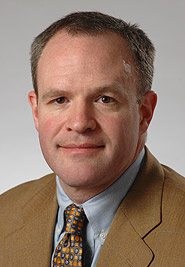Berkeleyan
Milestone attained in quest for cheap antimalarial drug
Because developing nations can't spare the $2.40 per person it would take to protect millions from disease and death, the urgency of developing still-cheaper treatments fuels the push to synthesize artemisinin precursors
![]()
| 19 April 2006
Researchers striving to create a less expensive version of a life-saving antimalarial drug, artemisinin, have cleared a major hurdle, according to a new report in the journal Nature.
 Jay Keasling's efforts to develop an affordable synthetic antimalarial drug have progressed systematically, the most recent milestone being his team's success in manufacturing artemisinic acid, a precursor to the best malaria drug currently available. (Peg Skorpinski photo) |
Two and a half years ago, a Berkeley team led by Jay Keasling, professor of chemical engineering and bioengineering, succeeded in engineering bacteria to make a chemical precursor of artemisinin - the best drug available today to cure malaria.
The team's ultimate goal was to retool the microbe's metabolism to perform as much of the drug synthesis as possible in order to sidestep the expensive laboratory synthesis needed to make artemisinin. That synthesis would have increased the drug's cost beyond the researchers' ambitious target of 25 cents per dose.
They now have nearly achieved that goal by engineering the production of artemisinic acid, one chemical alteration away from artemisinin. The fact that the researchers have not yet been able to produce artemisinin itself is not a disadvantage, they said, since drugs currently on the market - all made from extracts of the wormwood plant, Artemisia annua - are synthetic derivatives of both artemisinic acid and artemisinin.
"This is probably as close to artemisinin as we are going to get in microbes. The rest is going to be done by chemistry," said Keasling, whose lab partnered with the San Francisco-based Institute for OneWorld Health, a nonprofit pharmaceutical company, and Emeryville-based Amyris Biotechnologies to develop low-cost artemisinin drugs using Keasling's genetically engineered microbes. The partnership was funded by a $43 million grant from the Bill and Melinda Gates Foundation.
Keasling noted that his team achieved its recent feat in yeast, not E. coli bacteria. Bacteria breed faster and are often the microbes of choice, but the ability to get the drug out of both bacteria and yeast provides flexibility in achieving the goal of complete synthesis of artemisinin within another four years, he said.
Despite its achievement, the team cautioned that a microbe-produced version of artemisinin will not be on the market soon. It added that the current method of production - extraction from the wormwood plant grown by farmers in Asia - will be essential until production and widespread distribution of the less costly alternative becomes possible. That day is five to ten years away, they say. "While we have made a lot of progress in the past two years, there still are a lot of unknowns," Keasling said.
Hope for half a billion?
Artemisinin derivatives, in combination with other drugs, have proven nearly 100 percent effective against malaria, and thus represent a major hope for the 300 million to half a billion people each year who become infected with malaria, and the more than 1.5 million people - mostly children in Africa and Asia - who die. Even at $2.40 per person for a cure, however, the cost is too great for most developing countries.
In 2003, Keasling and his team pieced together bacterial genes, yeast genes, and genes from the wormwood plant to create a chemical pathway - essentially a miniature factory - in bacteria to make amorphadiene, an artemisinin precursor that can be converted chemically into artemisinin.
Supported by funding from the Gates Foundation, Keasling and his team will work with Amyris to push the research toward a final goal: a microbe that can make sufficient amounts of artemisinic acid to allow scientists to produce the antimalarial drug inexpensively enough for widespread use in Africa and Asia, where malaria is endemic.
To ensure affordability, Berkeley has issued a royalty-free license to both OneWorld Health and Amyris to develop the technology to treat malaria. Amyris will transform the Keasling lab's research into a robust fermentation process and perform the chemistry and scale-up necessary to bring the drug to market. OneWorld Health will conduct pre-clinical studies and implement a global access strategy for the drug.
More information on the collaboration between Berkeley, the Institute for OneWorld Health, and Amyris Biotechnologies to develop a low-cost malaria drug, can be found at www.artemisininproject.org. A detailed description of the researchers' work appears in the April 13 issue of Nature.

